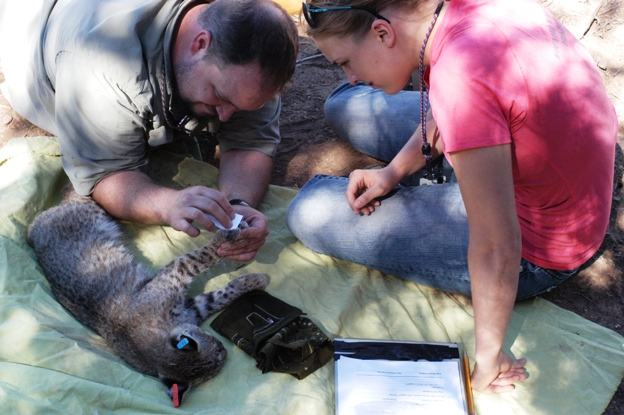Wild Pantex – Triple Play Bobcats
Article by Jim Ray, Pantex Wildlife Biologist/Scientist
Frequently, after checking my e-mail real quick in the mornings, I’ll venture out in my truck to check various trapsets that we have set for bobcats. On October 4, I made the first of five scheduled stops. I walked around the end of the treerow and made my way to the first trapset which consisted of two box traps.
Hmm, both trap doors were closed. Trapping had been slow all summer, so I wondered if it was the wood rats or striped skunks that we had been catching at this site. Not this time! A half-grown bobcat kitten peered out from one trap, and another kitten from the other trap. I then walked on down the treerow to the other double-trapset. The door was open on the first trap but, COOL, there was another bobcat kitten in the second. I returned to my truck and called my collaborators at West Texas A&M University (WTAMU) to get them on their way. I, then, headed out to check the remaining trapsets at other locations.
Even though bobcats had previously been recorded in the surrounding counties, the appearance of the mother of these kittens’ in 2006 was the first documentation at Pantex. By 2009, two bobcats with kittens were documented and Pantex contracted with Dr. Raymond Matlack with the Department of Life, Earth, and Environmental Sciences at WTAMU to collaborate on trapping, marking and tracking these cats on and around the facility. Since then, dozens of students, including Graduate Student, Lena Thurmond, who’s Master of Science Thesis will be based on the cats, have assisted in over 30 captures of bobcats on and around Pantex.
Back to the present….
As the WTAMU crew arrived an hour later, I joined them to take part in the processing of the cat. Today’s crew is team leader, James Skaggs, along with Erika Knowles, and Dustin Henderson. Laura Bailey with the Pantex Public Affairs Office joins us to take some photos.
Moments later WTAMU pokes the first kitten with a jab stick loaded with sedative and we back away, waiting for the sedative to take effect. Ten minutes later and its “bobcat down,” and time to get busy. The cat’s eyes remain open, but its body is limp. To combat the drying effects of the sedative we, periodically, use our hand to “blink” its eyes, while keeping its eyes covered in-between “blinks.”
I snap photos and help occasionally as WTAMU goes through the process:
- Determines sex
- Takes various measurements of the body and tail
- Weighs the cat
- Notes characteristics like scars, presence of ticks or fleas, etc.
- Inserts micro-chip under the skin of the shoulder blade area
- Takes a few drops of blood for DNA testing
- Places an ear-tag in each ear – unique colors to differentiate cats
Once finished, we place the sleeping cat back in the trap to recover for a couple of hours. Then it is on to the next cat, and then the next. All-in-all a good day; the trapping and marking of two female and one male bobcat kittens, ranging in weight from 8-11 pounds. That places them at about half the weight of their 20-21 pound mother that we have captured and weighed on three occasions.
Such is the normal processing of a bobcat. An adult cat would have received a GPS tracking collar, enabling us to track it and map its home range and habitat use. Perhaps, we will catch these guys again and they can be tracked like other adults.
The WTAMU crew hangs around for a few hours and lets the kittens out of the traps at about the same time. They’ll join up with their mother and continue to roam our Wild Pantex.

WTAMU students, James Skaggs and Erica Knowles working up a Pantex bobcat.
